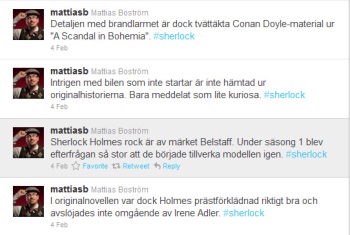This weekend another part of the series Sherlock was aired on Swedish national TV. It was broadcasted just after the first round of the Swedish part of the Eurovision Song Contest 2012.
As I wrote exactly a year ago, Twitter is the place to be when the ESC competitions are running. It is the talk of the day, and noone misses out of the opportunity to express awe, horror och sheer joy over the contestants. All in the company of a crowd that is mostly well known (people tend to discuss with people they already know), but in some part a huge anonymous crowd, available through hashtags.
This year, the social TV has taken a step forward. During the episode of Sherlock the other day, a Sherlock Holmes fan (a nerd as he calls himself) started to tweet information that added extra value. Mattias Boström, or @mattiasb, gave commentes on every scene that framed the episode with anecdotes and background information.
As a huge amount of people are already watching TV with their laptop, iPad or mobile phone at hand, it seems like watching two screens at the same time is not a problem. On the contrary, being a part of this social network that Twitter provides seems important, especially in front of the TV. A shared experience.
I myself was watching Sherlock and keeping an eye on Twitter as usual, when suddenly something interesting, valuable and entertaining came up in my stream. The tweets by Mattias Boström.
What Mattias Boström did was a spontaneous act of sharing stories around the series Sherlock. But what if the Swedish National TV themselves had offered this as a bonus? Timely tweets together with a helpdesk, answering questions and taking part in a dialogue around Sherlock. What does this bring to our experience of the television medium? I am curious to follow the development around TV broadcasting and social media. I am sure we’ve just seen the beginning of these multi channel experiences.


